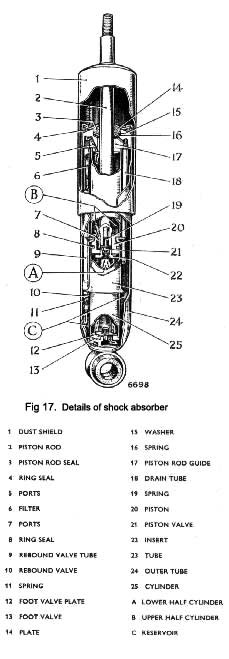Grip the upper end of the piston rod firmly with the hands and operate the shock absorber by moving the rod up and down.
The presence of air is usually indicated by a lack of resistance or a springy “feel” at the beginning of each stroke. If this is suspected, the shock absorber should be left in an upright position for a few minutes to allow bubbles of air to collect at the top of the pressure chamber.
With the shock absorber still vertical, a few short strokes from the fully compressed position followed by a few slow full strokes should remove all air from the pressure chamber.
Moderate and even resistance throughout the outward and inward strokes should be felt after expelling the air. If, however, the resistance is slight or erratic and free movement cannot be eliminated, then the shock absorber should be replaced by a new unit.
It is difficult to form an adequate opinion of the true operational condition of a shock absorber by hand testing. The slow hand speed only partially operates the “bleed” setting within the shock absorber and a large part of the road spring control depends on the high pressure or high speed setting which can only operate while the shock absorber is in service. A new shock absorber may appear to be weak when operated by hand, but this should not always be taken as evidence of a fault.
|
|
 **
**
